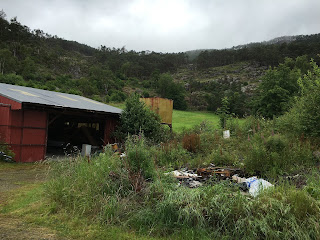Ole Olson Søndenå and Mari Iversdatter Nordskår primarily lived at Skåreflådå on the Nordskår farm outside the village of Fister in the municipality of Hjelmeland, county of Rogaland, Norway following their marriage on July 4, 1844 until they moved to the Finnestad farm northwest of Stavanger in 1863.
Over 170 years later, here are a few photos of what the property looked like a few years ago.
Below is a view of the inlet from one of the main houses that exist today on the Nordskår farm.
Over 170 years later, here are a few photos of what the property looked like a few years ago.
 |
| Skåreflådå on the Nordskår farm |
 |
| Skåreflådå on the Nordskår farm |
 |
| Skåreflådå on the Nordskår farm |
 |
| Skåreflådå on the Nordskår farm |
From the local archives which also provides insight regarding Norwegian immigration to the United States:
1) Skaareflaaden = skåreflådå
Skåre means a ledge, shelf, flattening of the mountain side. Skår = cut
Flådå means about the same, it is often used on a flat area in a steep terrain. Flat areas like that was suitable for farming.
2) Skåreflåden was a “husmannsplass”.
The English word for “husmann” is cotter (crofter is also used). Behind this term you will find a very heterogeneous group, with great geographical differences and equal great changes during history. But some conditions seems to have been common for all the husmenn:
- The farm land they used - 'husmannsplass' (cotter's holding) - was never registered as separate units. The land was owned by the farmer, but the cotter could own the houses.
- Their houses stood on land that belonged to a farmer. And to pay for renting the land the “husmann” had to word for the farmer.
- Their lease contracts were limited in time. The farmer could order the “husmann” to move if he wanted the land for himself or for somebody else.
The “husmann” class can be seen as the solution to a difficult problem: A growing population had to make a living in a country where the land resources didn't expand at the same rate. Many couples could get a farm, but not all. The last group became 'husmenn'. The 'husmenn' had to their disposal the poorest land resources, and they lacked any kind of permanent rights to use them. During the 1800's the 'husmann' group grew in numbers. Their means of living didn't get any better, most of them experienced harder times. Then came a new possibility - farmland in another country. The emigration to America was heavily recruited from the 'husmann' group.
3) The owner of the land was property #208, farm no. 1 at Nord-Skår. The farmer was Ivar Reiarson (1798-1878)
4) The buildings do not exist today. The “husmannsplass” was located where you find the name Flådå on the map....
Below is a view of the inlet from one of the main houses that exist today on the Nordskår farm.
 |
| View from Nordskaar |
Ivar Reiarson was the father of Mari Iversdatter Nordskår. Her family remained at the Nordskår farm after Ole Olson and Mari moved to the Finnestad farm near Stavanger.
Comments